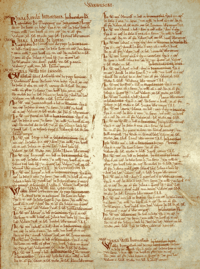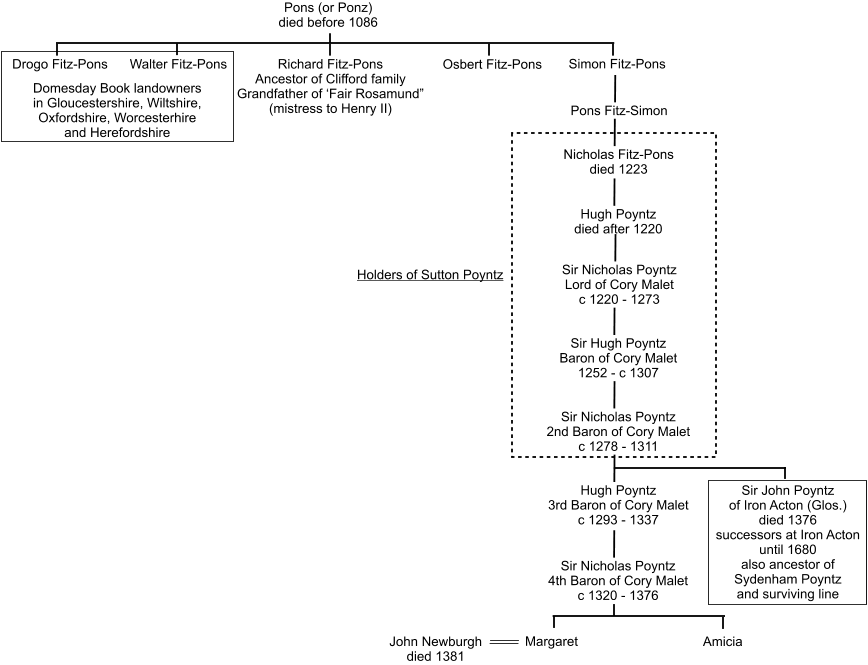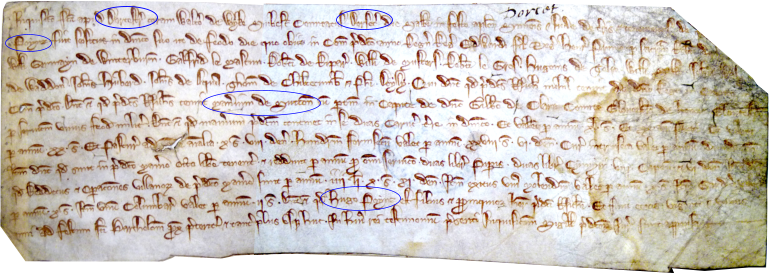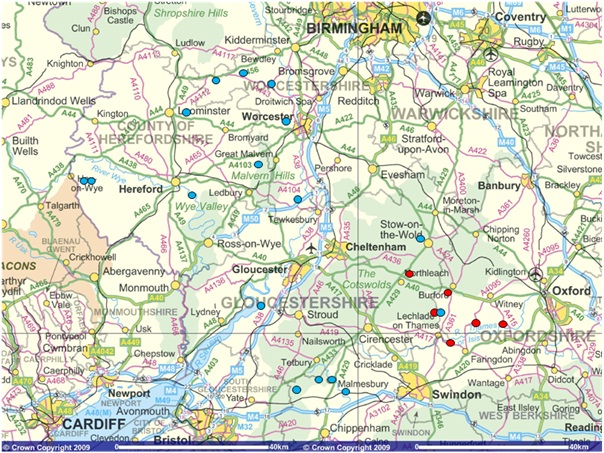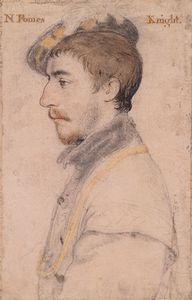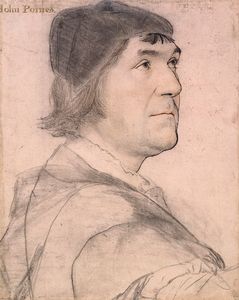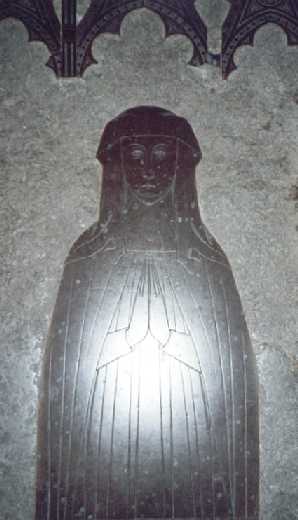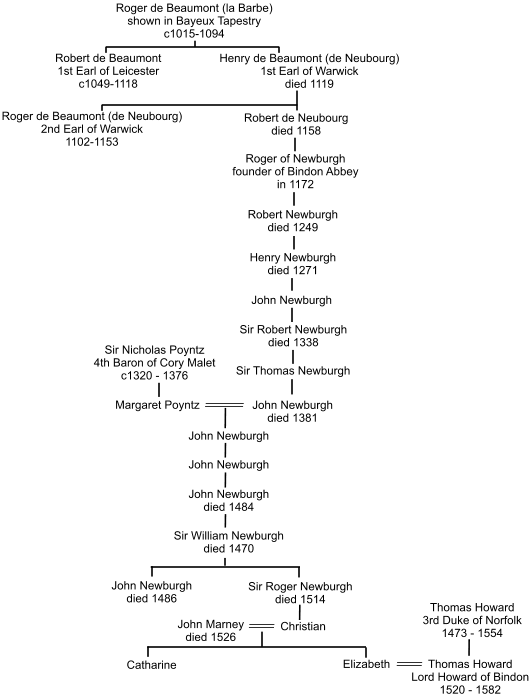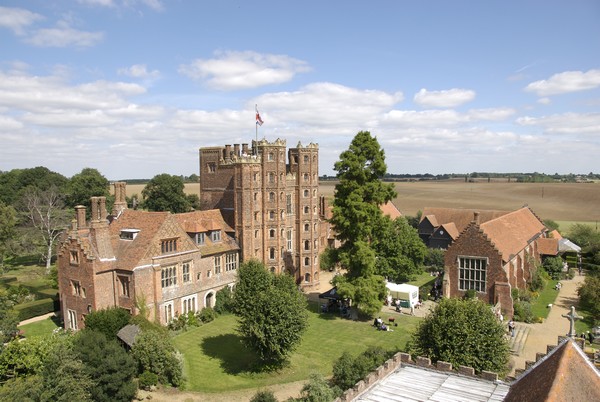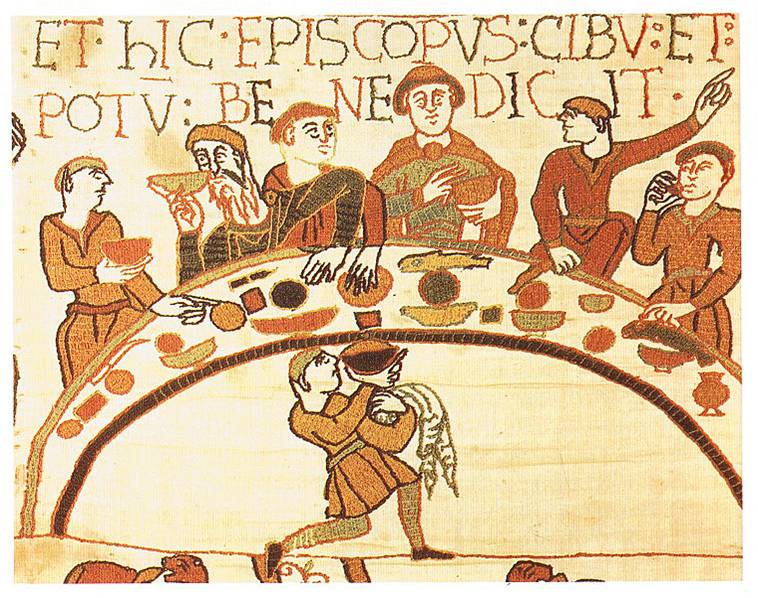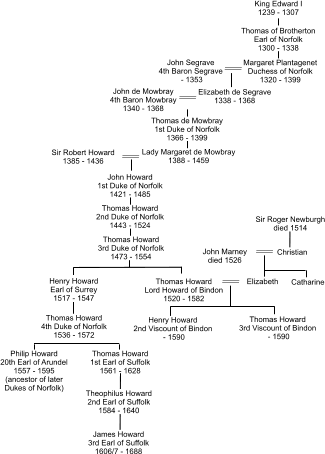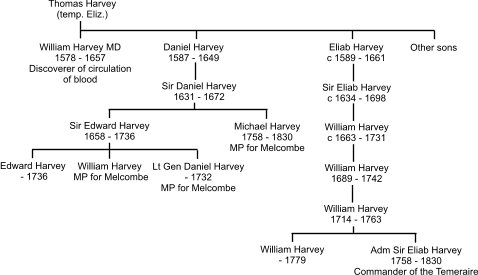Sutton Poyntz has existed since some time perhaps 100 years before the Norman Conquest. For all but the last 100 years or so, there was a Manor of Sutton Poyntz, which included most of the two villages of Preston and Sutton Poyntz; originally owned by the King, this Manor was then owned by a succession of land-owning families. The Poyntz family were one of those families, and although they did not own Sutton Poyntz for very long before selling it to the Bryans, they gave their name to the village. The Poyntz's seem to have originated in Gloucestershire, but lived at Curry Mallet in Somerset for most of the time they owned Sutton Poyntz
All these families had significant land-holdings. Three of these families (Newburgh, Howard and Weld) were based at Lulworth Castle; the other three families, including the Harveys, lived and had their main land-holdings elsewhere, and probably would have visited Sutton Poyntz rarely, if at all.
All these families are interesting in different ways. The following pages look at the origins, family trees, and personalities of these families.
The last family to own the majority of Sutton Poyntz were the Weld's of Lulworth Castle. They decided to sell up in 1925 - the sale was a major event in the history of the village, and was the trigger for a rapid expansion of the village down Sutton Road and up Plaisters Lane.
There is good archaeological evidence of a Roman manor at Preston, and also the remains of a Roman temple can still be seen on Jordan Hill, between Preston and Weymouth Bay [see for example Proceedings of the Natural History & Archaeological Society of Dorset, Vol 54 (1933) pp 21-34].
It is a reasonable surmise, based on what is known from other Roman sites in Britain, that the lands attached to this manor would have consisted essentially of what is now the parish of Preston cum Sutton Poyntz. The centre of economic wealth at that time, therefore, was beside the River Jordan, just south of the road through Preston, just a little south-west of where the village church now stands.
Roman archaeological finds have been found in Sutton Poyntz, not least in digs at and near Wyndings, up Plaisters Lane, which have found significant quatities of pottery [PDNHAS Vol 79 (1958) pp 112-113]. Roman-age structures have also been found in and around the waterworks in Sutton Poyntz (which used to be the site of the upper mill) [see "By a Crystal Brook" published by Wessex Water]. At present, however, no clear evidence has emerged of any pattern of Roman habitation or occupation in Sutton Poyntz.
The first written record that we have found relating to Sutton dates from 891 AD. In the 450 years or so between the end of Roman occupation and this date, nothing is known. However, the net effect over those years was a transfer of the economic 'centre' of the manor from Preston to Sutton. In Roman times, the manor was unambiguously at Preston, beside the River Jordan. By late Saxon times, a division had been effected somehow between the economic and ecclesiastical centres - the manor was located at Sutton Poyntz, and the chuch at Preston ("Priest's Town").
It is not known how or why this happened.
| Domesday Book, 1086 |
Before and after the Norman Conquest of 1066, the village of Sutton (as it was then known) was part of a Royal Manor. This is recorded in the Domesday Book (complied in 1086), in the following entry:
The King holds DORCHESTER, FORDINGTON, SUTTON [Poyntz], GILLINGHAM and `FROME'. King Edward held them.
It is not known how many hides are there because they did not pay tax before 1066.
Land for 56 ploughs. In lordship 7 ploughs; 20 slaves; 12 freedmen; 114 villagers and 89 smallholders who have 49 ploughs.
12 mills which pay £6 5s; meadow, 160 acres; pasture 2 leagues long and 1 wide; woodland 4 leagues long and 1 league wide. 5 cobs; 20 cattle; 72 pigs; 800 sheep; 40 goats.
This manor with its dependencies pays one night's revenue.
| Page from Domesday Book |
The meaning of this entry is that both King Edward the Confessor, before the Conquest, and King William after the Conquest held the manors listed direct, so that rents from the farmers and millers in those places would come straight into the royal exchequer, rather than through a land-holder (i.e. Lord of the Manor). The place called Frome is not clearly identified, but may be near West Stafford. This grouping was one of three 'Royal Manors' of similar size in Dorset - it seems likely that the rather strange grouping of places into units was to equalise the groupings in terms of size, so that they could all pay "one night's revenue", which literally means enough to keep the King and his retinue for one night.
Because Sutton was listed as part of a large grouping, we cannot say anything at all about the number of people, ploughs and mills in Sutton at this time.
| Saxon times |
The first written record of Sutton dates from AD 891. In this year, a Saxon deed records that Alfred, King of Wessex, exchanged land with one of his Counts, Behrtwulf. This Berhtwulf may have been the same person as a nobleman called Bertulf, from Essex, whose death is recorded in the Anglo-Saxon Chronicle in 897AD.
In exchange for Plush in Dorset, and land at Raddington in Somerset, the King obtained Sutton. This is presumably when Sutton became a Royal Manor for the first time.
| After Domesday Book |
After the Domesday Book in 1086, Sutton and Preston disappear from the record for over 100 years, until 1212, when an Exchequer document (the 'Testa de Nevill') says that Nicholas Poyntz holds the manor of Sutton, with the Duke of Gloucester as the land-holder in chief. There appears to be no evidence at all about when the King gave away the manor. Kings were in the habit of rewarding good service to the crown (for example in battle) by the gift of land (remember that in Feudal England, the land was almost all owned by the King, and granted for a 'Fee' to the land-holder. The Fee was often in the form of military service, but could take many other forms). Kings were also in the habit of punishing poor behaviour by the withdrawal of land-holding rights. So some time between 1086 and 1212, the Manor of Sutton Poyntz was granted to someone, but we do not have any clear evidence of when or who. For more discussion on this, see the section on the Poyntz family.
|
Poyntz family genealogy |
In 1086, the Domesday Book recorded that Sutton Poyntz was held by King William, as part of a Royal Manor. The next document that we have found so far that refers to Sutton Poyntz is in a taxation register known as "Testa de Nevill", dated 1212; this record states that Sutton Poyntz is now held by someone called Nicholas Poyntz, as part of the "honour" (i.e. Barony) of the Earl of Gloucester; at that time the Barony of Gloucester was held direct by King John.
Nicholas's son Hugh died before his father, so he did not own Sutton Poyntz (although it seems [Fine Rolls dated 1237] that his widow Helewise (nee Malet) held it in dower for a time). Later documents (known as Inquisitions post mortem) dated 1273, 1308 and 1311 show that the next three generations held Sutton Poyntz at their death, still as part of the honour of the Earls of Gloucester.
This Poyntz family may have descended from a man called Pons, aalive at the time of the Norman Conquest. Pons's existence is undoubted, but his ancestry of these Poyntz's is speculative. See below for more information.
| Poyntz, Barons of Curry Mallet |
Hugh Poyntz, who died in 1220, married a Somerset heiress called Helewise Malet, daughter and heir of William Malet of Curry Mallet (or Cory Malet as old documents show it). The Malet family, incidentally, was one of the few with an absolutely certain descent from someone who fought in the Norman army at Hastings. With the manor came a Barony (which at that time meant being summoned as a member of Parliament whenever the King called Parliament, usually so that he could raise a tax). The 5 generations of the Poyntz family who held the manor of Curry Mallet were:
- Sir Nicholas Poyntz, Lord of Curry Mallet, c1220 - 1273
- Sir Hugh Poyntz, 1st Baron of Curry Mallet, 1252-1307
- Sir Nicholas Poyntz, 2nd Baron of Curry Mallet, c1278-1311
- Hugh Poyntz, 3rd Baron of Curry Mallet, c1293-1337
- Sir Nicholas Poyntz, 4th Baron of Curry Mallet, c1320-1376
Note that dates of deaths are generally very well known, as "Inquisitions post mortem" (IPM's) were conducted on the death of any land-holder, to establish their what land they held, and who their heir was; these Inquisitions were recorded in documents that still exist. Birth-dates were not generally recorded, although other official documents often record the hearings held to establish when a land-holder had reached the age of 21.
The page for Dorset from the IPM for the Nicholas Poyntz who died in 1273
(N.B. The words and phrases highlighted are "Dorchester", "Dorset", "Poiynz",
"manerium de Sutton", and "Hugo Poiynz")
Click the image to download a higher resolution copy
Another duty of a land-holder was to fight in the king's army when called. Contemporary official records (Close Rolls) show that the Poyntz's fought in Wales and Scotland, and were excused certain taxes as a result.
| The end of the Poyntz line |
The last Sir Nicholas Poyntz died in 1376 with no son; the Barony of Curry Mallet thus ended. Sir Nicholas had two daughters, who succeeded to his lands. One daughter, Amicia, married a Somerset man called John Barry; they had one child, William, but Amicia, John and William all died without further heirs. All the lands thereby came to the family of the other daughter, Margaret, who had married a Dorset land-holder called Sir John Newburgh, of Lulworth. The obvious story is that Sutton Poyntz was among those lands, and so came, for the first time in its history (but not the last) to be part of the Lulworth estates. Hutchins [History and Antiquities of Dorset] seems to have followed this simple story, although he did note records that seemed to show Sutton in other hands. What really happened seems to have been much less simple, but we are now quite confident we understand the story.
| Sutton Poyntz after the Poyntz's |
Sutton Poyntz drops out of Poyntz family records after the death of Sir Nicholas Poyntz in 1311. The inquisitions post mortem [IPM dated 1337] for Hugh, 3rd Baron, does not include Sutton as being in his ownership (although note that another IPM entry [1329] shows that Hugh still held the manorial court at Sutton Poyntz). As far as ownership is concerned, the trail of evidence moves to the Chaundos family and then the Bryans and their descendants.
Between 1315 and 1361, Sutton Poyntz seems to have been granted as dowry to Maud (the widow of Sir Nicholas Poyntz) and her second husband, Sir Roger Chaundos. A Close Roll entry [1315] lists the properties granted to Maud on her re-marriage, and includes much of Sutton Poyntz liberty, but not Sutton Poyntz itself. However later documents [Feet of Fines 1330 and Book of Aids 1346] are clear that Maud and Roger held Sutton Poyntz.
After Maud's death in 1361, Sutton Poyntz returned to the grandson of Sir Nicholas, the last Nicholas Poyntz. This Nicholas Poyntz seems to have had severe financial difficulties, and sold much of his inheritance. As soon as Sutton Poyntz came back into his possession on his grandmother's death, he sold Sutton Poyntz to Sir Guy de Bryan [Feet of Fines 1361 and 1362]. The Bryan's and their descendants then held Sutton Poyntz for 100 years, although there does seem to have been some dispute about the Bryan title. Finally, a court arbitration awarded it (as a result of there being no further descendants of Sir Guy de Bryan) to John Newburgh. There remains some mystery about this; it is not clear why the court concluded that the Newburgh's had any claim to Sutton Poyntz, which had been sold 100 years earlier. The court's verdict is recorded, but not their reasoning, so the mystery will probably never be solved.
| When did Sutton become Sutton Poyntz? |
Dorset, in particular, and Wessex in general, is full of places with double-barrelled names, where the name (or sometimes rank) of the owning family has been added to the original place-name. Often this has had the effect of generating names with a peculiar west-country lilt, all of their own. Some examples from Dorset (other counties like Hampshire, Somerset and Devon have their own, but we do not need to look outside Dorset for wonderful instances):
- Bere Regis, Melcombe Regis and Winterborne Kingston - places owned direct by the King;
- Stoke Abbott, Milton Abbas and Winterbourne Abbas - owned by an abbey or abbot;
- Toller Fratrum and Winterborne Monkton - owned by the brothers of a monastery (Toller Porcorum doesn't quite fit this pattern!);
- Langton Herring, Kingston Russell, Hazelbury Bryan, Winfrith Newburgh, Combe Keynes, Worth Matravers, Melcombe Bingham, Bradford Peverell, Wootton Fitzpaine, Fifehead Neville - all retaining memory of the families that owned the villages in the Middle Ages.
Is there a word for this habit of adding an owner's name to a place-name, or for the type of place-name that results? Whatever, Sutton Poyntz fits totally into the pattern. There is absolutely no mystery about Sutton Poyntz's name (unless perhaps you choose to puzzle over what Sutton is to the south of). But when did simple Sutton become known Sutton Poyntz? We are still trying to establish this. The earliest reference we have found so far is in an Inquisition Post Mortem (an enquiry into the land-holdings of someone recently died) dated September 1314; this was an enquiry into the holdings of Gilbert de Clare, earl of Gloucester, from whom the Poyntz family held Sutton Poyntz. It is possible that the village was called Sutton Poyntz in this document in order to distinguish it from other places called Sutton in the Earl's large land-holdings. What is clear is that over the next hundred years or so, Sutton became known more and more frequently as Sutton Poyntz.
| What's in a name? |
In medieval times, spelling was notoriously variable. The name we now know as Poyntz was spelled in many ways - Poynz, Poyntz, Poinz, Pointz, Ponz and others. Gradually, the spelling settled down. What is really fascinating, however, is that the family name and place name settled in different ways, and were only brought back together fairly recently. By the 16th Century, the family name seemed to be spelled universally in the modern way - Poyntz. The village, however, was called Sutton Pointz, until some time in the early 19th Century when there was evidently a determined move to change its name to match that of the family. The watershed seems to have been around 1830; after that, the village was called Sutton Poyntz. It would be nice to know more about this - what did the villagers think about it, who were the people urging the change, was there some single event that changed the name?
| Other Poyntz's |
Sir Nicholas Poyntz, 2nd Baron, had two other sons as well as Hugh: Nicholas Poyntz (yet another Nicholas) went into the church, and became Vicar of Hoo in Kent. The youngest son, Sir John Poyntz succeeded to his mother's estate of Iron Acton, near Tockington on the north side of Bristol. Click here for information on some of the interesting descendants on this line of the Poyntz family, which continues to this day.
| Who were the Poyntz's? |
Early family genealogy is always fraught with difficulty, but Burke's Peerage, recognised as about the most authoritative source, lists a family tree as in the illustation here. The Nicholas Poyntz shown as a holder of Sutton Poyntz in the medieval document called Testa de Nevill is listed in Burke's Peerage as Nicholas Fitz-Pons, and is known to have died in 1223. After him, 4 generations of Poyntz's are recorded as having held Sutton Poyntz.
Nicholas is believed to have descended from someone called Simon Fitz-Pons, the youngest of five sons of someone called Pons. We know that Pons existed, and lived around the time of the Norman Conquest, firstly because an early document belonging to Westminster Abbey shows that he gifted land at Wallingford to the Abbey, and secondly because the Domesday Book lists two significant land-holders, Drogo and Walter, as "sons of Pons". The map below shows the land-holdings of Drogo (as blue dots) and Walter (red dots). So Pons existed, and had at least two sons; as his sons were land-holders in 1086, we can infer reliably that Pons himself had died before that date.
|
Manors held in Domesday Book by Drogo (blue dots) and Walter (red dots), sons of Pons |
The existence of the younger sons of Pons is inferred rather than proved. Another brother shown in the accepted genealogy is Richard, who seems to have held land on the Welsh borders. He was the ancestor of the Clifford family, later Barons de Clifford and Earls of Cumberland. Richard's grand-daughter, Rosamund Clifford (Fair Rosamund) was mistress to King Henry II.
| And who was Pons? |
There is no documentation about who Pons was. The Clifford family have suggested that he was a Norman, and was the son of a Norman noblaman, William Comte de Hiemes. It is a reasonable guess that he was Norman rather than Anglo-Saxon, to justify the land-holdings of his sons soon after the Conquest. But we can be fairly certain that the Comte de Hiemes was not his father; a Norman monk called William de Jumieges wrote a book in 1070 in which he listed the three sons of the Comte, all known and none of them identifiable with Pons [see below].
A medieval document called the "Battle Abbey Roll" lists Pons as a member of the Norman army at Hastings, but this whole document dates from much later, and is of very dubious value [see below].
So sadly, we conclude that the background and history of Pons is lost forever.
See page 11 of Volume 2 of "The Gesta Normannorum Ducum of William de Jumieges, Orderic Vitalis and Robert of Torigni, Volumes 1 and 2" edited and translated by Elisabeth van Houts. The "Gesta Normannorum Ducum" was a contemporaneous record of the Dukes of Normandy, written by a monk called William de Jumieges in about 1060, and then extended in 1070 to include the Conquest. It was further extended later, to include events up to the reign of Henry I. A snippet view of Volume 2 is available on the internet, including the list of the sons of William Comte de Hiemes.
The "Battle Abbey Roll" was allegedly a list of the people who fought in the Norman army at Hastings, erected at Battle Abbey. The roll itself either never existed or has been lost; the earliest copies of the list of people date from the 16th Century, and are known to have a number of errors and inconsistencies. In fact, there are only 15 people (or perhaps 21) who can be shown confidently to have fought with Duke William at Hastings. Pons is not among them, but two people on the list have much later family relationships with the Poyntz's - Robert de Beaumont, whose younger brother may have been ancestor of the Newburgh's, and William de Malet, ancestor of Helewise Malet who married Hugh Poyntz, bringing him the Lordship of Curry Mallet in Somerset.
| Other Poyntz's |
Sir Nicholas Poyntz, 2nd Baron, had two other sons as well as Hugh: Nicholas Poyntz (yet another Nicholas) went into the church, and became Vicar of Hoo in Kent. The youngest son, Sir John Poyntz succeeded to his mother's estate of Iron Acton, near Tockington on the north side of Bristol. Here are some of the most significant descendants of this John Poyntz.
|
Sir Nicholas Poyntz, of Iron Acton
|
|
John Poyntz
(both drawings by Hans Holbein the younger)
|
Sir Nicholas Poyntz, 2nd Baron, had two other sons as well as Hugh, the 3rd Baron: Nicholas Poyntz (yet another Nicholas) went into the church, and became Vicar of Hoo in Kent. The youngest son, Sir John Poyntz succeeded to his mother's estate of Iron Acton, near Tockington on the north side of Bristol. This line of the Poyntz family, which continues to this day, produced some interesting descendants.
Sir Nicholas Poyntz, of Iron Acton (c1506 - 1557). Sir Nicholas owned Acton Court, the manor of Iron Acton, near Bristol. In 1535, King Henry VIII visited Acton Court, with his new wife Anne Boleyn (who incidentally was a first cousin of a later owner of Sutton Poyntz, Thomas Howard, Viscount of Bindon). Sir Nicholas set about building a complete new wing to Acton Court, furnishing and decorating it lavishly for the King's visit. This is the building that is now seen when you visit Acton Court - little is left of the older medieval manor house.
John Poyntz, food taster to Queen Katherine (c1490 - 1544). John was uncle to the Sir Nicholas just described. John's father, Sir Robert Poyntz, fought for Henry VII at the Battle of Bosworth, and was later Chancellor to Katherine of Aragon. John gained the job of 'sewer' (food taster) to Queen Katherine. The line of the Poyntz family at Acton Court died out in 1680; John Poyntz is the ancestor of the present Poyntz family, and of Sydenham Poyntz, soldier extraordinaire.
Maj-Gen Sydenham Poyntz (1607 - ?). Sydenham Poyntz was born in 1607, to a merchant family living at Reigate in Surrey. In 1625, he ran away, and joined the Dutch army. Over the next 20 years or so, he fought for various armies, apparently changing sides at least once during the Thirty Years War. While fighting for the Imperial Spanish army, he rose to the rank of Major-General. In 1644, he returned to England, in order to join the Parliamentary Army, for whom he led the Northern Association army to a victory at Rowton Heath. He then initiated the siege of Newark, which ended the First Civil War. Poyntz then quarelled with Cromwell over strategy and the politicisation of the New Model Army. He fled the country, only to return in 1647 as a Major-General in the Royalist army. When the Royalists were defeated in the Second Civil War, Poyntz fled the country again, to the West Indies and probably then North America. He never returned to England, and his final fate is not known.
For a period of about 100 years, essentially corresponding with the 13th Century, Sutton Poyntz was owned by members of the Poyntz family, who lived initially in Gloucestershire and then at Curry Mallet in Somerset. Between 1315 and 1361, Sutton Poyntz was not owned by the Poyntz family, being part of the dowry given to the widow of one of the Barons Poyntz of Curry Mallet.
In 1311, Sir Nicholas Poyntz died, and Sutton Poyntz is known to have been among the lands that he held at his death. Hugh Poyntz, his son and heir, was a minor (aged about 18), and therefore became a ward of the King, as was the custom then. The King, also in accordance with the custom, 'sold' the right of wardship, probably to the highest bidder; in this instance to William le Latimer.
After Sir Nicholas's death in 1311, Maud (also known as Matilda), Sir Nicholas's second wife, re-married, to a Hertfordshire land-owner called Sir Roger de Chaundos, 1st Lord Chaundos (or Chandos as the name later appeared). It appears that Sutton Poyntz was among Dorset land gifted to Maud as a dowry on her second marriage. A document dated 1315 in the Close Rolls lists the properties granted to Maud in dowry; they include some parts of the manor of Sutton Poyntz (Putton and East Chickerell), but do not name Sutton Poyntz explicitly. However later documents (1330 and 1346) do explicitly state that Sutton Poyntz was part of Maud's dowry.
Little seems to be known definitely of the origins of the Chandos family, but Sir Roger lived in Herefordshire, and was Sheriff of that county, and also Sheriff of Glamorgan, on various occasions. The Sir John Chandos who fought at Crecy was probably a cousin to Sir Roger. Sir Roger was an ancestor, via a female line, of the Dukes of Buckingham and Chandos (to whom Jane Austen was distantly related), including the 1st Duke of Chandos who was a patron of Handel, and to whom the Chandos Anthems were dedicated.
Sir Roger and Maud had a son, Sir Thomas, and a grandson Sir John (who married a daughter of Guy, Lord Bryan); after this the male line died out. The title of Lord of Chaundos continued, passed down via a sister of Sir John who married into the Brydges family, a descendant of whom married the First Duke of Buckingham and Chandos.
The grant of property as dowry was only for the lifetime of Maud, so when she died, in 1361, ownership of the manor of Sutton Poyntz returned to the Poyntz family, and specifically to Sir Nicholas Poyntz, the step-grandson of Maud.
| Sale to the Bryan family |
Sutton Poyntz was owned by the Poyntz family from before 1212 until the death of Sir Nicholas Poyntz in 1311. In 1315, the manor was granted to Sir Nicholas's widow Maud as dowry on her re-marriage, to Sir Roger de Chaundos, a Hertfordshire land-owner. Sutton Poyntz was then owned by Roger & Maud Chaundos, until Maud's death in 1361.
|
Genealogy of Chandos and Bryan, showing relationship to Poyntz and Newburgh |
In 1361, the ownership of Sutton Poyntz returned to the Poyntz family, to the grandson of Sir Nicholas, another Nicholas. He, however, took immediate steps to sell it. There is a sequence of Deeds, dated 1361 and 1366, which deal with the sale of Sutton Poyntz to Sir Guy de Bryan (Lord Bryan). Lord Bryan was an extremely influential person who held a number of important posts including Admiral of the Western Fleet, and was clearly a personal friend of the King. He was from a family that originated in Devon (Tor Bryan), but held other land (such as Hazelbury Bryan) in Dorset.
| Alice Bryan and her daughters |
Lord Bryan died in 1390. Two of his sons, Guy the younger and Philip, had pre-deceased him; a third son, William, survived him but seems to have been estranged from his father and did not inherit Sir Guy's properties. Lord Bryan also had at least two daughters (one of whom married the grandson of Sir Roger and Maud de Chaundos), two of whom died childless. Sir Guy's extensive properties therefore passed to his only grandchildren, Philippa and Elizabeth, daughters of Guy the younger. Philippa and Elizabeth were both children, so the properties were effectively taken over by their mother, Alice. Alice de Bures, who was born at Bures in Suffolk, was an heiress in her own right, and became an extremely wealthy woman. Very unusually for the time, she never remarried after the death of her first husband, although she lived on for a very long time, dying in 1435.
At her death, Alice was shown as the owner of Sutton Poyntz; in 1385/6, Lord Bryan had vested the manor in himself and Alice, with remainder to the descendants of Alice and Guy the younger. Thus on Lord Bryan's death in 1390, Sutton Poyntz became Alice's personal property rather than going to her children as soon as they were of age.
Alice's older daughter, Philippa, married twice but died in 1406 without having had any children. All the estates then went to the other daughter Elizabeth. An order in the Fine Rolls for 1435 concerns the transfer of Sutton Poyntz from Alice, who had just died, to her daughter Elizabeth. For a time, this is the last definite record we have found of Sutton Poyntz, so the next few steps are currently conjectures.
| Elizabeth Bryan and her family |
At this point, as a result of the death of her older sister Philippa and of her mother Alice, Elizabeth owned all of the estates that had belonged to her grandfather Lord Bryan, and also the estates (mainly in Suffolk and Essex) belonging to her mother.
Elizabeth had married Sir Robert Lovell of Rampisham, the second son of John Lovell, 5th lord Lovell of Titchmarsh [see Victoria County History for Titchmarsh in Northamptonshire]. They had one daughter, Maud. Elizabeth died in 1437, just two years after her mother. Unfortunately, the records do not include an inquisition post mortem report on any lands belonging to Elizabeth in Dorset, so although we know she inherited Sutton Poyntz in 1435, there is no similar record in 1437.
| Later, the Earldom of Arundel was inherited by the Howard family, Dukes of Norfolk, who took the family name FitzAlan-Howard. A younger son of the 5th Duke of Norfolk owned Sutton Poyntz. |
Maud, the daughter of Robert and Elizabeth Lovell, married twice. Recent sources disagree about which marriage came first (and some even omit her marriage to Richard Stafford), but we are reasonably sure that Maud's first marriage was to a Wiltshire landowner called Sir Richard Stafford, son of Sir Humphrey Stafford of Hooke in Dorset. They had one daughter, Amicia. The other marriage was to John FitzAlan, 14th earl of Arundel. John's father, also John, had inherited the earldom in 1415 from a distant cousin, and had died in 1421. Maud had one son by John FitzAlan, Humphrey, who became the 15th earl in 1435 at the age of 6, on the death of his father.
Maud died in 1436. Her son Humphrey died at the age of 9 in 1438, after which his uncle became the 16th earl of Arundel.
| Earl of Ormond |
Humphrey's half sister Amicia now became the sole heir to the de Bryan and de Bures estates. Amicia, the great-granddaughter of Alice de Bures, was now the only living descendant of Lord Bryan, who had bought Sutton Poyntz. At this point, in 1438, Amicia had lost her half-brother, her mother, her grandmother and her great-grandmother, all within the space of three years. Some sort of record (not the sort one wants to match)!
We can confidently infer that Amicia was under age when she inherited the family estates, but we have not yet found any record of who was appointed as her guardian. At some point (date not known), Amicia married James Butler, earl of Wilts, who later became the 5th earl of Ormond.
The next record we have of Sutton Poyntz, which clearly shows that Sutton Poyntz was now owned by James and Amicia Butler, was a rather curious one. In 1447, a court arbitrated on a dispute over the ownership of Sutton Poyntz, between James and Amicia Butler, on the one hand, and John Newburgh on the other. This record is lodged in the Dorset History Centre. The result of the arbitration was that Sutton was awarded to James and Amicia and to "the heirs of their body" (i.e. any direct descendants of Amicia and/or of James), with remainder, should both James and Amicia die without children, to John Newburgh. Subsequent court records document the formal enshrinement of this agreement.
Amicia died in 1456. James, the earl of Ormonde, was executed in 1461 after the Battle of Towton, in which he fought on the losing side. They had no children; therefore, under the agreement reached in 1447, the manor of Sutton Poyntz passed to John Newburgh.
What was John Newburgh's claim to Sutton Poyntz? Contemporary documents do not show, and we have not been able to find any relationship between the Newburgh's and the Chaundos's or Bryan's. Two other documents may be relevant. One, dated 1409, seems to show that the families of the two last Poyntz daughters were questioning Alice de Bryen's right to Sutton Poyntz, but they agreed to leave Alice as owner for her lifetime. A second, dated 1428, refers back to a much earlier (1330) Poyntz family deed which granted the manor effectively to the heirs of the last Nicholas Poyntz, and challenges the then occupants of the manor to show why John Newburgh (as Nicholas Poyntz's heir) should not be the rightful owner. But we cannot see any reason why the later sale of Sutton Poyntz to Lord Bryan should not have extinguished any rights contained in that 1330 deed. At the moment, we would greatly welcome any suggestions of what the Newburgh claim might have been.
1. Towards the end of the life of Guy Bryan the older, he laid two charges against his only remaining son, William Bryan. The charges were: (a) that William had caused the terms of leases of some of Guy's property to be changed, against Guy's wishes, so that, in the absence of any male-line grandchildren of Guy's, the properties would be inherited by William's heirs, rather than by Guy's heirs; and (b) that William had stolen various documents relating to properties owned by Guy. The effect of the changes to the leases was subtle, but could have led to the property passing to William's daughters, if he had any, rather than the two daughters of Guy's oldest son, Guy the younger, and his wife Alice. In practice, we do not believe William had any children, so it would not have mattered; but the charges led to William being arrested, and seems to have led to him being cut out of Guy's inheritance.
2. There is a beautiful church brass showing Lady Alice de Bryan at All Saints Church, Acton, in Suffolk. From documentary evidence contained in our list of sources, Alice de Bryan was born Alice de Bures, daughter of Sir Robert de Bures (c1334-1361). Sir Robert de Bures's parents were Sir Andrew de Bures (died 1360) and Alice de Raydon. Probably, Sir Andrew's father was another Sir Robert de Bures, the subject of another brass in Acton Church, said to be the third oldest brass in the country.
Alice's mother was Joan (probably born Joan de Sutton), who subsequently married Sir Richard Waldegrave M.P., Speaker of the House of Commons. Sir Richard's will speaks of Alice de Bryan as his 'sister', although actually she was his step-daughter. Sir Richard was evidently a close confidant and colleague to Lord Bryan, leading to Alice's marriage to Lord Bryan's oldest son Guy.
3. When James Butler, Earl of Ormond, was executed and attanted (losing his lands), several families made claims to be heirs to the Bryan family estates (see also a history of Kingsdon in Somerset for more information). One of these families was the Percy family, Dukes of Northumberland, who are still patrons of Hazelbury Bryan church. His, and various other claimants, based their claim on descent from Elizabeth Bryan, who they believed was a daughter of Lord Bryan; this belief was clearly accepted as the Duke of Northumberland was recognised as the chief heir. However, some more modern genealogies, starting with Cockayne's Complete Peerage, have Elizabeth as a sister to Lord Bryan rather than a daughter, which (if true) would have left most of the claimants with no claim whatever to much of the land.
|
Newburgh family genealogy |
In 1447, a court arbitration hearing was held at Cerne Abbas, to judge between rival claims over the ownership of Sutton Poyntz. The claimants were Amicia Stafford and her husband James Butler, earl of Wiltshire, on the one hand, and John Newburgh of Winfrith and East Lulworth on the other. The arbitration awarded the manor of Sutton Poyntz to Amicia and James and "the heirs of their bodies" (i.e. any children, grand-children etc. they may have), with remainder to John Newburgh and the heirs of his body. In simple terms, Amicia and James would continue to own it and would pass it down to their children, but if they had no children, then John Newburgh would take ownership.
Sutton Poyntz had been owned by the Poyntz family between some time before 1212 and 1315. In 1315, it was given as dowry to the widow of one of the Poyntz's when she re-married, to Sir Roger de Chaundos. In 1361, when it came back to the Poyntz family, it was sold to Sir Guy de Bryan, and passed down the Bryan family, eventually to Amicia Stafford, who married the earl of Wiltshire.
Amicia died in 1457, and James was beheaded after fighting on the losing side at the Battle of Towton. Neither of them had any children. The manor of Sutton Poyntz therefore came to John Newburgh in 1461, in accordance with the 1447 arbitration. We know for sure that John Newburgh owned it, from the inquistion post mortem entry at his death in 1483.
| Origins of the Newburgh family |
The Newburgh family had lived in Dorset at least since about 1150, since records [see for example Hutchings History and Antiquities of Dorset] show them as the founders of Bindon Abbey; this abbey was originally created near the sea below Bindon Hill, on the east side of Lulworth, but was moved by the Newburgh's to its later site to the east of Wool. The Newburgh's became patrons of the abbey. Initially, the Newburghs lived at Winfrith Newburgh (which of course got its name from them); later records show them as holding, and living at, East Lulworth.
The earlier origins of the Newburgh's is less certain, but one plausible theory is that they were descended from a Norman nobleman, an important supporter of King William I, called Roger de Beaumont. This Roger is shown in the Bayeux Tapestry, eating with Duke William shortly before the Conquest. One of his sons held the lordship of a place in Normandy called le Neubourg. This story, although uncertain, is described below.
| The Newburgh's and Sutton Poyntz |
In about 1350, one of the Newburgh's of Winfrith and Lulworth, John Newburgh, married an heiress called Margaret Poyntz. Margaret was one of two daughters of Sir Nicholas Poyntz, the 4th Baron Poyntz of Curry Mallet. Under the inheritance laws applying at the time (the laws of primogeniture), family estates would pass to the oldest son. Sir Nicholas, however, had no son, so his estates were shared between his two daughters, and eventually came to John Newburgh and his heirs when Margaret's sister died without heirs of her own.
The Poyntz estates therefore came to the Newburgh family. For reasons that are described above, however, these estates did not include Sutton Poyntz, which had been sold to the Bryan families.
As noted above, a court abritration in 1447 ruled on the ownership of Sutton Poyntz, which was claimed by John Newburgh and by Amicia Butler, a descendant of the Bryan's. It is not clear at all to us at the moment, however, how the Newburgh's had any claim to the manor. Just possibly, John Newburgh made a successful claim that, should Amicia die without having any children, there would be no direct descendants of Sir Guy de Bryan who had bought Sutton Poyntz from the Poyntz's in 1361, and that if this was the case, the manor should be returned to the heirs of Sir Nicholas Poyntz who sold the manor. And that descendant was him, John Newburgh. This claim, if that was indeed the claim he made, seems to us to be fallacious on two counts.
- Firstly, it seems to rely on a confusion between the Sir Guy de Bryan who bought Sutton Poyntz and his son, also called Sir Guy de Bryan (Guy the younger). Guy the older, who bought Sutton Poyntz in 1361, did in fact still have direct descendants, through a daughter. The only living descendant of Guy the younger was indeed Amicia, so if she died without children, his line would end.
- The second reason why this claim, if made, was wrong, is that the sale in 1361 was to Guy de Bryan "and the heirs of Guy", rather than "and the heirs of his body". This rather technical point means that if the direct line died out, the manor would pass to other more distant relations of Sir Guy de Bryan.
Nevertheless, it is clear that the court arbitration did in fact accept whatever arguments John Newburgh put forward, and that when James and Amicia died without children, Sutton Poyntz did indeed pass to John Newburgh.
It is interesting to note that the other very extensive properties inherited by Amicia from her ancestors were the subject of a battle royal when she died, involving the Butler family, earls of Ormonde (through James's marriage to Amicia, and the Percy's, earls of Northumberland, the Poynings family and the Seymour family, all of whom claimed some descent from Sir Guy de Bryan. See for example the very interesting history of the Bryans in the website on the village of Kingsdon in Somerset.
|
Layer Marney Tower - Tudor palace of Marney family (with the tallest gate-house in the country) |
| The end of the Newburgh line |
By 1484, at the death of the John Newburgh who recovered ownership of Sutton Poyntz, the "inquisition post mortem" recorded the land holdings of John, including Sutton Poyntz. The estates passed to John's grandson, another John (John's son having pre-deceased him). This John Newburgh only lived another two years, and the estates then passed to his brother, Sir Roger Newburgh.
When Sir Roger died, in 1514, he had no sons, so the estates passed to his daughter Christian, and her husband John Marney, lord of Layer Marney. John Marney came from an important Essex land-owning family; his father Henry set out to built a palace at Layer Marney, which John continued to his death in 1526. John and Christian had no sons, but two daughters, Catherine and Elizabeth. They were still minors when their father died, but eventually inherited the family estates, including the Essex estates of their father and the Dorset estates of their mother.
Sutton Poyntz was in the portion of the estate that was allocated to Catherine, the elder daughter. Catherine married twice, firstly to George Ratcliffe and secondly to Thomas, lord Poynings. Catherine had no children, and in accordance with the law of the time, the Dorset estates should then have passed to the other sister. It seems, however, that Baron Poynings hung on to the estates, and at his death passed them to his brother Adrian. This caused a legal mess that was not sorted out for many years, made more complex still because the two Poynings brothers were what was technically known as 'aliens' having been born abroad. Baron Poynings sold Layer Marney (to Lord Audeley), and bought additional lands in South Dorset, including West Lulworth, Wool, Bovington, East Ringstead and East Burton. Much of this was later sold on to Thomas Howard, so strengthening and enlarging the Lulworth estates significantly.
So eventually, partly by inheritance and partly by purchase, the enlarged Lulworth estates (including Sutton Poyntz) came into the possession of the younger Marney sister, Elizabeth, and her husband, Thomas Howard, a member of one of the most important and fascinating families in England. Which is another story ....
| The de Beaumont's |
Roger de Beaumont was a Norman lord, about 12 years older than William the Conqueror. When Duke William of Normandy (as he was then) had to deal with disputes about his right to the Dukedom, Roger was one of William's strongest and closest allies.
By 1066, when Duke William invaded England and defeated King Harold, Roger was past his fighting days, but nevertheless Roger is depicted in the Bayeux Tapestry, at what was presumably a planning meeting before the invasion - Roger (known as 'la Barbe') was the one shown with a full beard, unusual for the time. Roger's older son, Robert, fought at the Battle of Hastings, and led a Norman troop on the right wing "with the utmost bravery and success". He was rewarded with the Earldom of Leicester.
Roger lived until 1094, but it seems he probably retired for the last years of his life, possibly to a monastery. However, he is shown in the Domesday Book of 1086 as the owner of just a few pieces of England. They are all in Dorset, and although they do not include either Winfrith or Lulworth (which were held by the king himself), they do include Steeple and Church Knowle, just to the east of Winfrith.
Roger's second son was Henry de Beaumont. Henry did not fight at Hastings (probably too young), and was not immediately granted any lands in England. Henry was granted the lordship of a place near Rouen in Normandy, called Neubourg, and became known as Henry de Beamont de Neubourg. In 1088, there was a revolt by Norman lords against the recent succession of king William II. The background to this was that William the Conqueror awarded his Norman lands and dukedom to his older son, Robert, and his English lands and crown to his second son, William - many of the Norman lords felt this was a slight to Robert and to them, and revolted against William II. Henry was one of the lords who supported William II, and helped to put down the rebellion. For this, he was granted the earldom of Warwickshire, and significant lands in England. We have not yet found proof, but it is very plausible that Henry might have been granted lands in Dorset, including those of his father when he died.
Henry passed on his dukedom of Warwick, with the lands pertaining to that, to his eldest son (also called Roger de Beaumont). He passed his lordship of Neubourg to a younger son, Robert de Neubourg. It is inferred (but without strong proof) that Robert de Neubourg also was granted lands in Dorset, and was the father of the first Newburgh for whom we have definite documentary evidence at Winfrith, Roger de Novo Burgo who in 1172 gave land near Wool for the new Bindon Abbey site. The evidence that Robert and Roger were father and son seems to be strong, but not certain - just possibly the manor of Winfrith could have been awarded to a supporter of the de Beaumonts, rather than to a direct descendant. We will probably never know for sure - however it is interesting that the Manor of Winfrith was held by the Newburgh's in excahnge for the supply of water to the Royal Court, rather than the normal military duties; this could perhaps imply a closer tie to the King than normal.
|
Howard family genealogy |
The Howards were one of the most important and significant families of late medieval England. They were also one of the most dangerous - a family that kings of England could not do without, but had to handle with extreme care. A succession of Howards lost their titles and lands (and occasionally their heads), but the family kept being restored to its glory.
Origins and rise of Howards
The Howard family itself does not have roots of great antiquity, but quickly rose to a position of importance through strategic marriages. In particular, Sir Robert Howard married the daughter of Thomas de Mowbray, the Duke of Norfolk, who was descended through his mother and grandmother from King Edward I. When the Mowbray line died out, this allowed Sir Robert's son, John Howard, to become Duke of Norfolk, a title his descendants still hold. John Howard and the next four generations of Howards lived through the Tudor age, rising and falling in power as the nation's religion changed and as monarchs came and went.
Inheritance of Lulworth estate
The 3rd Duke of Norfolk was uncle to two of King Henry VIII's wives, Anne Boleyn and Katherine Howard. This Duke had two sons. The younger son, Thomas Howard, married Elizabeth Marney, daughter of John Marney and grand-daughter of the last of the Newburgh line. He thereby inherited half of the Newburgh estates based at Lulworth. Eventually, by inheritance and purchase, he came to own the whole Lulworth estate, including Sutton Poyntz; he took the title Viscount Howard of Bindon (after Bindon Abbey, near Winfrith Newburgh).
This Thomas Howard was succeeded, in lands and title, by his two sons, Henry and Thomas. These two seem to have been extremely unpopular, and Henry, in particular, is alleged to have indulged in piracy. However, they both died without heirs, after which the Lulworth estate passed to their distant cousin, Thomas Howard, 1st Earl of Suffolk.
Earls of Suffolk
The 1st Earl of Suffolk was the younger son of the 4th Duke of Norfolk, who was first cousin to Henry and Thomas (Viscounts of Bindon). His mother was Margaret Audley, an heiress, through whom he inherited Audley End and other land in Suffolk. In early life, he was an admiral, fighting against the Spanish. After illness curtailed his military career, he held a variety of significant posts, culminating in the office of Lord High Treasurer to King James I. As his influence rose, he initiated a huge (and unaffordable) building programme, including the building of a new Audley End House, the largest private house in England.
His fortunes then crashed; he was accused by the king of embezzlement from the royal treasury, and of extorsion. He was fined, and imprisoned for a time. Although he was released from prison, he never gained his former position.
The 1st Earl of Suffolk was succeeded, in title and estates, by his son and grandson. His grandson, James Howard, sold the Dorset estates in 1641, to Humphrey Weld. The list of properties sold includes Cullifordtree Hundred, but does not explicitly include Sutton Poyntz. For reasons that are not clear, it seems that Sutton Poyntz was sold separately, to Eliab Harvey of Rolls Court in Essex.
|
Howard family genealogy |
From 1483 to the present day, the Howards have held a number of titles, of which the pre-eminent is that of Duke of Norfolk. The first few to hold this title were as follows:
1st Duke
John Howard was the grandson of Thomas de Mowbray, a Duke of Norfolk in a previous creation of the title. John Howard was a staunch Yorkist, and in particular a supporter of King Richard III. After Richard's coronation in 1483, John was created Duke of Norfolk, the Mowbray line having died out. John Howard then died, with King Richard, at the Battle of Bosworth Field. In Richard III, Shakespeare has John Howard sent a message on the eve of the battle, saying:
Jocky of Norfolk, be not too bold, For Dickon, thy master, is bought and sold
2nd Duke
After Bosworth, the new king, Henry VII, annulled the Howard titles and stripped them of their lands. However the next in line, Thomas Howard, eventually proved his loyalty and value to Henry VII and then Henry VIII, and had his titles restored, first the Earldom of Surrey and later his Dukedom. Thomas Howard was grandfather to two Queens of England, Anne Boleyn and Katharine Howard.
3rd Duke
The 3rd Duke of Norfolk was another Thomas. In his early years, he fell partly out of favour, in particular conflicting with Thomas Wolsey on policy. Thomas's fortunes grew when the king married Anne Boleyn, Thomas's neice. After Wolsey's fall, Thomas had his father's Dukedom restored. For a time, Thomas's importance and fortune grew, especially when a second neice, Katherine Howard, became Queen. Even Katherine's execution did not lead to a loss of Thomas's power. But Thomas eventually lost his position as a result of acts by his son, Henry Howard, Earl of Surrey. Henry, who was one of the first English poets to use the sonnet form, offended Henry VIII ostensibly by using part of the royal arms in his insignia (although this was part of a wave of arrests perhaps induced by the king's illness). Both Henry and Thomas Howard were arrested, tried and condemned to death; Thomas lost his title. Henry was executed, but Thomas was saved because the king died before the date of his execution.
Thomas was held in the Tower of London throughout the reign of Henry VIII's son, Edward VI. When Queen Mary succeeded, Thomas Howard was released, and had his titles and lands restored. Thomas died peacefully aged 81.
4th Duke
| Remember that the 15th Earl of Arundel, Humphrey FitzAlan, had owned Sutton Poyntz about 80 years before, but died aged 9. He had inherited Sutton Poyntz from his mother Maud Lovell |
He was succeeded as Duke of Norfolk by his grandson, the 4th Duke of Norfolk, yet another Thomas Howard. This Thomas married Mary FitzAlan, daughter of the 19th Earl of Arundel; he and his descendants by her thereby eventually took the additional title of Earls of Arundel, and changed their family name to FitzAlan-Howard. After Mary's death, Thomas married another heiress, Margaret Audley; their eldest son built Audley End, then the largest stately home in England.
The 4th Duke leant towards Catholicism , and seems to have offended Queen Elizabeth in various ways. Charges were brought against him, which may or may not have been true; these included scheming to marry Mary Queen of Scots, and involvement in a treasonable plot to put Mary on the English throne. He was condemned, had his Dukedom removed, and was executed. The Dukedom was then not restored until four generations later.
Harvey family genealogy |
The Harvey family stemmed from a successful Kent merchant in Elizabethan time, a period when the ancient pattern of wealth deriving from the ownership of land was changing rapidly, and fortunes were to be made from trade. Little is known of Thomas Harvey, but he was Mayor of Folkestone in 1600. He had seven sons and two daughters. Interestingly, descendants of one son were Members of Parliament for Weymouth, although they did not live in Dorset, and had no particular connection with Sutton Poyntz.
Dr William Harvey
The most distinguished of Thomas Harvey's sons, by far, was his oldest son, William Harvey. William was educated at King's School, Canterbury, and then at Caius College, Cambridge. After Cambridge, he took a second degree in Medicine, at the University of Padua. He practiced medicine at St Barts in London, and steadily rose, becoming Physician to King James.
William Harvey's claim to immortality was based on a single, ground-breaking, scientific publication, called De modu cordis. In this, he broke with ancient tradition about the nature of the flow of blood in the body. This tradition derived from an excellent and hugely influential Greek physiologist, Galen, who in the 2nd Century AD had maintained that blood in the body consisted of two separate flows - the veinous flow which transported nutrients from the liver to the organs of the body, and arterial flow which brought heat and air from the heart. William Harvey's research and publication demonstrated for the first time that this had in fact to be all one single flow, connected via capillaries (whose existence he had to hypothesise and was not proved until a few years after his death when microscopes were powerful enough to observe them), and powered by the heart.
Owners of Sutton Poyntz
| Eliab has never been a common English forename, although three Harvey's had the name. Three separate Eliab's are mentioned in the Bible; the most significant was the oldest brother of King David. |
The fifth son of Thomas Harvey was called Eliab Harvey. He was a successful merchant in his own right, and purchased an estate near Chigwell in Essex, where he built a mansion called Rolls Park.
In 1641, James Howard, 3rd Earl of Suffolk, sold most of his Dorset estates (which the Howard's had inherited about 100 years earlier) to Weld Family. For reasons that still need research, Sutton Poyntz was sold to Eliab Harvey. We believe this sale was direct from James Howard to Eliab Harvey, who both lived in East Anglia.
The Harvey family then owned Sutton Poyntz for the next 150 years. As they lived at Rolls Park, Sutton Poyntz was a somewhat remote part of their land-holding.
Admiral Sir Eliab Harvey
The last Harvey to own Sutton Poyntz was Admiral Sir Eliab Harvey. This Eliab Harvey joined the Royal Navy as a 13-year old, although he seems (in line with quite common practice) not actually to have ventured to sea until he was 15. When he was 20, his elder brother died, and he inherited the family's large estates and wealth. For a time after that, he did not spend much time at sea - despite that, promotion came his way, so that by the age of 25 he was made up to Captain. In 1790 and again in 1793 (at the outbreak of the French Revolutionary Wars), he was recalled to active service. He commanded a number of ships, but his most important command was of HMS Temeraire (the "fighting" Temeraire), at the Battle of Trafalgar in 1805. In this battle, he evidently tried to sail past HMS Victory to the vanguard of the British fleet, but was sent back to his proper station by a signal from Nelson. Harvey and the Temeraire fought brilliantly at the battle, and Harvey was rewarded by promotion to Rear Admiral; he was also a pall-bearer at Nelson's funeral.
In 1809, Admiral Harvey quarelled over tactics with his senior officer, Admiral of the Fleet Lord Gambier. As a result of this, although he received further promotions, he was never again apponted for active naval service.
Outside his naval career, Admiral Harvey was elected as a Member of Parliament on several occasions. As a young and very wealthy man, he led a racy life style. On one occasion, it is reliably reported that he gambled £100,000 on a single game, on the occasion of his 21st birthday. The story goes that the victor offered merely to take £10,000, on the basis that Harvey could not afford the full amount; Eliab Harvey insisted on gambling again for the difference, and this time won. Apparently even the £10,000 was never paid.
Whether it was because he needed money to feed his gambling, or whether it was because his naval career left him insufficient time for outlying parts of his land-holdings, some time in the early 1790's, Eliab Harvey sold Sutton Poyntz. He sold it to the owner of the Lulworth estate, Thomas Weld; this sale reunited Sutton Poyntz and Preston with the remainder of the Lulworth estate, which had been sold to the Weld's about 150 years before.
The Weld family purchased the Lulworth Estate from the Howard family in 1641. For reasons that are unknown, Sutton Poyntz was not included in the sale. The Weld family came originally from Eaton near Tarporley, in Cheshire. Some time in the 1590's, Humphrey Weld, a younger son, took the road from Cheshire to London, where he did rather well, becoming a senior member of the Worshipful Company of Grocers; he was Sherriff of London in 1599, knighted in 1603, and Lord Mayor of London in 1608.
It was Humphrey's grandson, another Humphrey, who purchased the Lulworth Estate, and settled at Luworth Castle (which had been completed about 30 years earlier). It is not obvious what brought him to Dorset, but he later served as Governor of Portland Castle, and as MP for Christchurch. Humphrey had no sons, and on his death the Lulworth Estates were inherited by his nephew William, whose descendants still own and live at Lulworth.
In the 1790's, William's great grandson, Thomas, purchased the Manor of Sutton Poyntz from the Harvey family, thus reuniting Sutton Poyntz with the rest of the Lulworth Estate. Sutton Poyntz was then owned by the Weld family for over 120 years, but was sold in lots in 1925, as part of the planning for a triple dose of death duties, soon after the death of Reginald Weld aged 81, with the Estate being inherited first by Reginald's 69-year old brother and then by a 71-year old cousin.
Thomas Weld, who purchased Sutton Poyntz, had an older brother Edward who died quite young. Edward married twice, the second time to a girl called Maria Smythe. After Edward's death, Maria married again, to Thomas Fitzherbert who also died quite young. Maria Fitzherbert had one other marriage (albeit not officially recognised) to George, Prince of Wales, later King George IV.
The Welds of Lulworth were of the Catholic faith. Thomas Weld's oldest son, another Thomas, took the priesthood, and in 1830 became the first English Cardinal in well over 100 years (if one does not count Henry Stuart, brother to the Young Pretender Charles Stuart, who was Italian by birth and upbringing). The previous English Cardinal was Philip Howard, a great-great nephew of Thomas Howard, 1st Earl of Suffolk, who had owned the Lulworth Estate and Sutton Poyntz.
The Weld family of Lulworth Castle owned the Manor of Sutton Poyntz (which included most of Preston and Sutton Poyntz) from about 1795 until 1925. In 1925, as part of planning for a triple dose of death duties, the Weld family put the majority of the land in the Manor up for sale, in lots. Copies of the Sales Prospectus are quite widely available, including at the Dorset History Centre. The Prospectus conntains a map to identify the lots, and provides useful historical descriptions of all the properties.
The property put up for sale included 6 main farms (Jordan Farm, South Down, Sutton Farm, Coombe Barton, North Down Farm, and Court Farm, with land totalling over 1600 acres), three other land holdings totalling just over 200 acres, Preston Beach, one cottage with 12 acres, and about 60 smaller dwellings or groups of dwellings. Most of the lots were eventually sold to existing tenants. Prices varied from £10 for small single cottages with a long term tenant, up to £19,000 for one of the largest farms.

